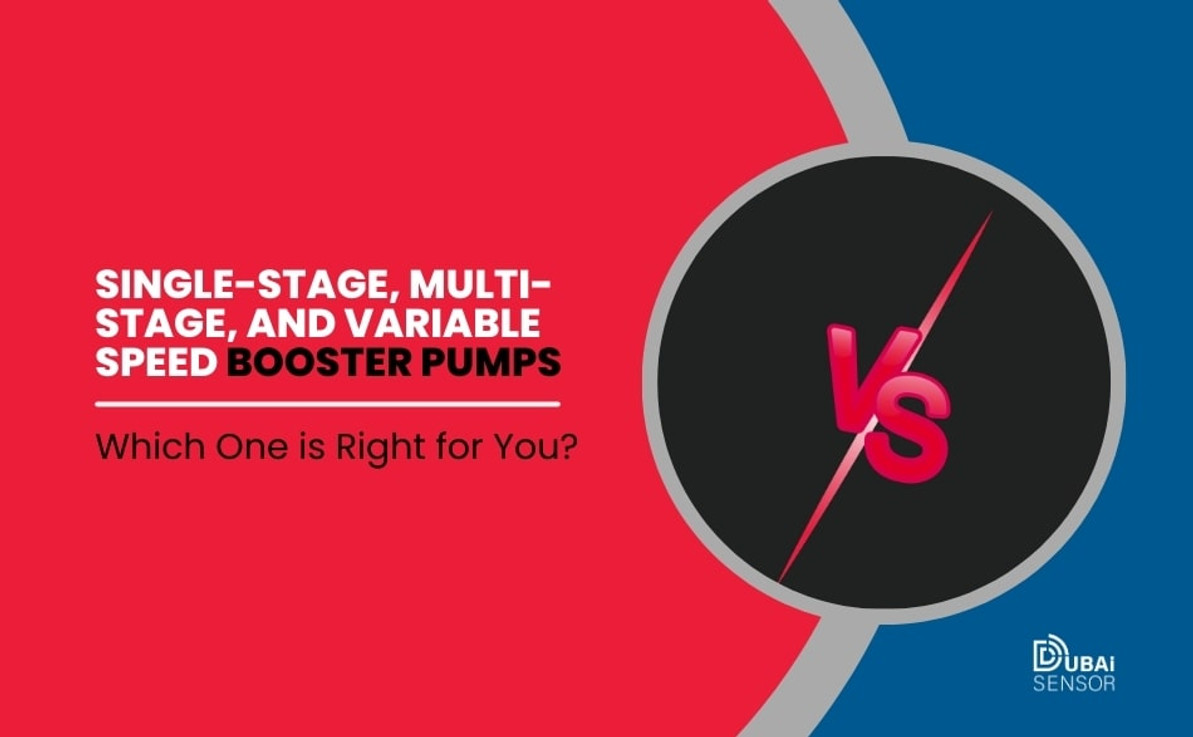Single-Stage, Multi-Stage, and Variable Speed Booster Pumps: Which One is Right for You?
1. Introduction
Is your shower lacking the invigorating pressure you crave? Do your faucets trickle instead of flow, making daily chores frustratingly slow? You’re not alone. Low water pressure is a common issue for homeowners and businesses alike, and it can make even the simplest tasks—like washing dishes or watering your garden—feel like a hassle.
The solution? A booster pump.
But with so many options available, how do you know which one is right for you? Should you go for the simplicity of a single-stage pump, the power of a multi-stage pump, or the advanced efficiency of a variable-speed pump? Each type has its strengths, and the choice depends on your unique water system needs.
In this guide, we’ll take you on a journey to uncover the best booster pump for your home or application. From understanding the basics of how booster pumps work to comparing their performance, efficiency, and ideal use cases, we’ll equip you with the knowledge to make an informed decision.
Don’t let low water pressure hold you back. Read on to discover how the right booster pump can transform your daily routines, improve efficiency, and bring a steady flow of convenience into your life. Let’s dive in!
2. Understanding Booster Pumps
Booster pumps are indispensable tools for ensuring adequate water pressure and flow in homes, businesses, and industrial settings. Whether you're dealing with low water pressure in a residential home or managing a large-scale system, understanding how these pumps work and why they're needed is essential.
What Are Booster Pumps?
A booster pump is a device designed to increase the pressure and flow of water in a plumbing or water supply system. It works by drawing water from a source, such as a municipal supply, a well, or a storage tank, and pressurizing it before delivering it to your fixtures or appliances. Booster pumps are commonly used in situations where water pressure is insufficient to meet specific needs, such as:
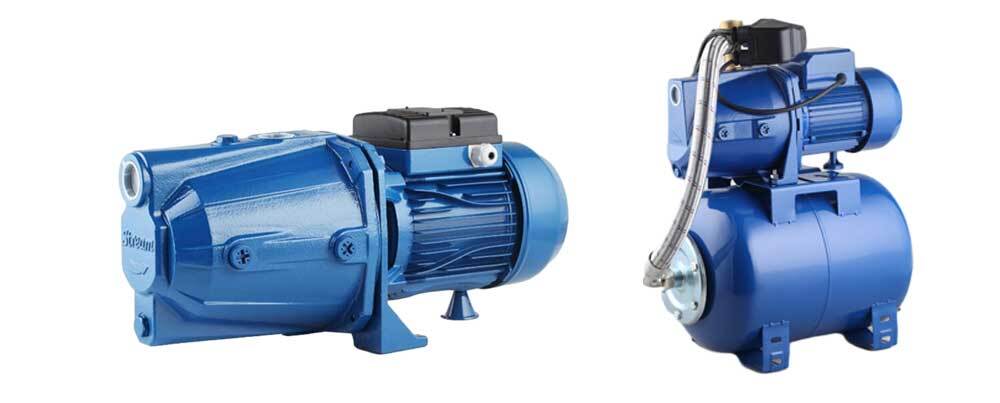
Fig 1. Two types of booster pump
Multi-story homes with low municipal water pressure.
Properties with water systems relying on storage tanks.
High-demand applications like irrigation, firefighting, or commercial water systems.
By addressing water pressure issues, booster pumps ensure smoother, more efficient operation of appliances and improved comfort in daily water usage.
How Do Booster Pumps Work?
Booster pumps operate by increasing the water pressure within the system using a combination of suction, pressurization, and controlled discharge. Here’s a simplified breakdown:
Intake: The pump draws water from a source, such as a municipal line, well, or tank.
Suction: A low-pressure zone is created inside the pump, causing water to flow into the pump’s intake pipe.
Pressurization: Water is passed through an impeller (or multiple impellers in some cases), which spins at high speed, imparting kinetic energy to the water and increasing its pressure.
Discharge: The pressurized water exits the pump and is delivered to its destination, such as household fixtures or irrigation systems.
Advanced booster pumps may also include:
Pressure Switches or Sensors: Automatically activate or deactivate the pump based on water demand.
Variable Frequency Drives (VFDs): Adjust the pump’s motor speed to match real-time water usage, ensuring constant pressure and energy efficiency.
Common Causes of Low Water Pressure
Understanding the causes of low water pressure can help determine if a booster pump is the right solution. Some common causes include:
Municipal Water Supply Issues: Fluctuating demand in municipal systems, especially during peak hours, can lead to inconsistent pressure.
Building Height and Elevation: Homes located at higher elevations or with multiple stories may experience lower pressure due to gravitational forces.
Modern Appliance Demands: Devices like water purifiers, large showers, and smart toilets require higher water pressure for optimal performance.
Aging Infrastructure: Older plumbing systems or corroded pipes can restrict water flow, reducing pressure.
With this foundational knowledge, you’re better equipped to understand how booster pumps can solve water pressure problems and improve overall system performance. In the next section, we’ll explore the unique features and benefits of single-stage booster pumps.
3. Single-Stage Booster Pumps
Single-stage booster pumps are a popular choice for addressing low water pressure in residential settings. Designed with simplicity and efficiency in mind, these pumps use a single impeller to boost water pressure, making them ideal for applications where moderate pressure increase is required.
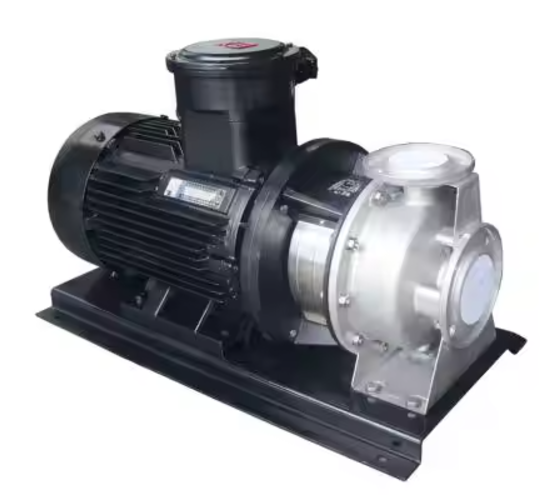
Fig 2. Single-stage booster pump
What Are Single-Stage Booster Pumps?
Single-stage booster pumps are equipped with one impeller that draws water into the pump, pressurizes it, and then discharges it at a higher pressure. Their straightforward design makes them compact, cost-effective, and easy to install. They are typically used in:
- Single-story homes.
- Applications with low to moderate water pressure requirements.
- Smaller irrigation systems or garden sprinklers.
How Do They Work?
The single-stage booster pump operates using a simple yet effective mechanism:
- Water Intake: Water enters the pump through an intake pipe.
- Impeller Action: The impeller rotates at high speed, creating centrifugal force that pressurizes the water.
- Pressurized Discharge: The water exits the pump at a higher pressure, ready to be delivered to fixtures or appliances.
Applications of Single-Stage Booster Pumps
These pumps are best suited for:
- Residential Water Pressure Boosting: Ideal for homes with moderate pressure issues, ensuring smooth water flow to showers, faucets, and appliances.
- Small-Scale Irrigation: Effective for watering small gardens or operating lawn sprinklers.
- Basic Plumbing Systems: Used in straightforward setups where water demand is consistent and pressure requirements are not extreme.
Advantages of Single-Stage Booster Pumps
- Cost-Effective: Affordable upfront costs make these pumps a budget-friendly option.
- Easy Installation: Their compact design allows for quick and hassle-free installation, even in smaller spaces.
- Low Maintenance: Simple construction reduces the need for frequent maintenance or repairs.
- Energy Efficient for Moderate Demands: Consumes less energy compared to multi-stage or variable-speed pumps in low-demand scenarios.
Disadvantages of Single-Stage Booster Pumps
- Limited Pressure Capabilities: These pumps are not designed for high-pressure applications or multi-story buildings.
- Inconsistent Performance Under Varying Demand: Single-stage pumps operate at a fixed speed and may not adapt well to fluctuating water demands.
- Noise Levels: Can be noisier than advanced models like variable-speed pumps, especially when running continuously.
Is a Single-Stage Booster Pump Right for You?
Single-stage booster pumps are an excellent choice if:
- You live in a single-story home or a property with low to moderate water pressure issues.
- You need a simple and affordable solution for a smaller water system.
- Your water demand remains relatively constant without frequent fluctuations.
In the next section, we’ll explore multi-stage booster pumps, which offer higher pressure capabilities and are ideal for more demanding applications. Stay tuned to see if they’re the right fit for your needs!
4. Multi-Stage Booster Pumps
Multi-stage booster pumps are designed for applications that demand high water pressure and efficient performance. Built with multiple impellers arranged in series, these pumps deliver significantly higher pressure compared to their single-stage counterparts, making them ideal for large homes, multi-story buildings, and demanding water systems.

Fig 3. Muli-stage booster pump
What Are Multi-Stage Booster Pumps?
A multi-stage booster pump uses multiple impellers housed in separate chambers to progressively increase water pressure as it flows through the pump. Each impeller adds energy to the water, resulting in a higher cumulative pressure output. These pumps are versatile, reliable, and suited for a wide range of applications, including residential, commercial, and industrial systems.
How Do They Work?
The operation of a multi-stage booster pump involves a series of pressurization steps:
- Water Intake: Water is drawn into the pump through an intake pipe.
- Sequential Impeller Action: As water passes through each impeller, it gains additional pressure, ensuring high efficiency and performance.
- Pressurized Discharge: The pressurized water exits the pump at the desired pressure level, ready for distribution to the system.
This staged process allows for precise control of water pressure, making these pumps suitable for high-demand scenarios.
Applications of Multi-Stage Booster Pumps
Multi-stage booster pumps are widely used in scenarios where consistent and high-pressure water delivery is essential, such as:
- Multi-Story Homes and Buildings: Ensures adequate water pressure on upper floors.
- Irrigation Systems: Ideal for long pipelines and sprinkler systems requiring high-pressure water.
- Industrial and Commercial Settings: Supports high-pressure requirements in manufacturing, firefighting systems, and water distribution networks.
Advantages of Multi-Stage Booster Pumps
- High Pressure and Flow Rates: Capable of delivering significant pressure increases for demanding applications.
- Energy Efficiency: Designed to optimize energy usage by distributing the workload across multiple impellers.
- Durability: Built to withstand high pressures and heavy-duty usage.
- Versatility: Suitable for various applications, from domestic to industrial systems.
Disadvantages of Multi-Stage Booster Pumps
- Higher Initial Cost: More expensive than single-stage pumps due to their complex design.
- Larger Size: Requires more space for installation, which might be a limitation in compact areas.
- Maintenance Complexity: The additional components and impellers may require more frequent servicing.
- Noise Levels: Can be noisier than single-stage pumps, especially at higher operational capacities.
Is a Multi-Stage Booster Pump Right for You?
Multi-stage booster pumps are a great choice if:
- You live in a multi-story building or own a large property with high-pressure needs.
- You require a pump that can handle long pipelines or large irrigation systems.
- You’re looking for an energy-efficient solution for high-demand applications.
- You’re willing to invest in a more robust system that offers long-term reliability and performance.
Multi-stage booster pumps excel in scenarios where consistent, high-pressure water delivery is crucial. However, for homes or systems with varying water demand, a variable-speed booster pump might offer greater flexibility and efficiency. In the next section, we’ll explore variable-speed booster pumps and their cutting-edge features.
5. Variable-Speed Booster Pumps
Variable-speed booster pumps are the pinnacle of efficiency and performance in water pressure solutions. Equipped with advanced technology, these pumps automatically adjust their motor speed to match real-time water demand, ensuring consistent pressure, energy savings, and a longer lifespan. They are particularly ideal for applications where water demand fluctuates throughout the day.
What Are Variable-Speed Booster Pumps?
A variable-speed booster pump integrates a variable frequency drive (VFD) controller that regulates the pump’s motor speed based on current water pressure and flow requirements. Unlike fixed-speed pumps, which operate at a constant speed regardless of demand, variable-speed pumps dynamically adapt, providing precise control over water delivery. This makes them a preferred choice for energy-conscious users and modern households with varying water needs.
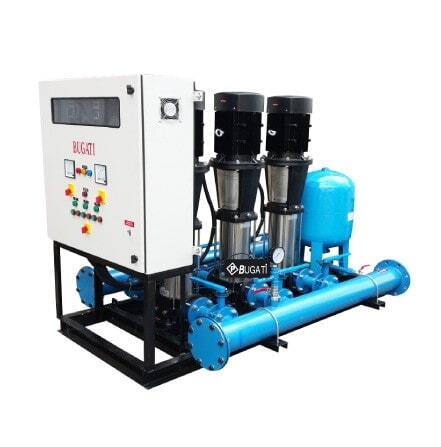
Fig 4. Variable-Speed Booster Pump
How Do They Work?
The key feature of variable-speed booster pumps is their ability to adjust operation dynamically:
- Pressure Monitoring: Sensors detect changes in water pressure within the system.
- Motor Speed Adjustment: The VFD controller modulates the motor speed to maintain the desired pressure level.
- Automatic Operation: The pump speeds up during peak demand and slows down during periods of low usage, ensuring optimal performance and efficiency.
- Pressure Stabilization: By avoiding sudden surges, the pump provides a steady and consistent water flow, even in fluctuating conditions.
Applications of Variable-Speed Booster Pumps
Variable-speed pumps excel in scenarios where water demand changes frequently:
- Residential Systems: Ideal for households with varying water needs, such as during peak morning and evening hours.
- Commercial Buildings: Ensures consistent water pressure across multiple floors and fixtures.
- Irrigation Systems: Perfect for systems with changing flow requirements, such as drip irrigation or sprinkler setups.
- Energy-Sensitive Applications: Used in places where energy conservation is a priority.
Advantages of Variable-Speed Booster Pumps
- Constant Pressure: Maintains stable water pressure by adjusting speed to match demand.
- Energy Efficiency: Saves energy by operating only at the speed required, reducing electricity costs.
- Soft Start and Stop: Eliminates pressure surges during startup and shutdown, protecting pipes and fixtures.
- Noise Reduction: Operates at lower speeds during light demand, resulting in quieter operation.
- Longer Lifespan: Reduced wear and tear due to adaptive operation extends the pump’s durability.
Disadvantages of Variable-Speed Booster Pumps
- Higher Initial Cost: Advanced technology comes with a higher upfront investment.
- Complex Installation: May require professional installation and setup to ensure optimal performance.
- Maintenance Requirements: Although infrequent, repairs or replacements of electronic components, like the VFD, can be more costly.
- Dependent on Electrical Supply: Requires consistent and reliable power to operate effectively.
Is a Variable-Speed Booster Pump Right for You?
Variable-speed booster pumps are a perfect choice if:
- You have a household or system with fluctuating water demand.
- Energy efficiency and long-term savings are priorities.
- You want a pump that provides constant pressure without manual adjustments.
- Quiet operation and advanced technology are important to you.
Why Choose Variable-Speed Over Fixed-Speed Pumps?
- Efficiency Gains: Variable-speed pumps consume only the energy required, unlike fixed-speed pumps that operate at maximum power regardless of demand.
- Sustainability: These pumps are more environmentally friendly, as they reduce overall energy consumption.
- Better Protection: The soft start feature minimizes the risk of pipe bursts and system damage.
- Future-Proof: Advanced technology ensures they are compatible with modern plumbing systems and appliances.
Variable-speed booster pumps represent the most advanced and adaptable solution for boosting water pressure. In the next section, we’ll summarize the key differences between single-stage, multi-stage, and variable-speed pumps to help you identify the best option for your needs.
6. Key Differences Between the Pump Types
Choosing the right booster pump for your water pressure needs requires understanding the key differences between single-stage, multi-stage, and variable-speed booster pumps. Each type has unique features, advantages, and ideal use cases. Here’s a side-by-side comparison to help you make an informed decision.
1. Performance
- Single-Stage Pumps:
- Deliver moderate pressure suitable for low-demand systems.
- Best for single-story homes or applications requiring consistent but low pressure.
- Multi-Stage Pumps:
- Provide significantly higher pressure through multiple impellers.
- Ideal for multi-story homes, large properties, or high-pressure systems such as irrigation and industrial processes.
- Variable-Speed Pumps:
- Offer precise control over water pressure, adapting to fluctuating demand.
- Provide constant pressure across varying flow rates, ensuring optimal performance in any scenario.
2. Energy Efficiency
- Single-Stage Pumps:
- Generally efficient for low-demand, consistent systems.
- Energy consumption is fixed and proportional to runtime.
- Multi-Stage Pumps:
- More efficient than single-stage pumps for high-pressure applications, as multiple impellers share the workload.
- Variable-Speed Pumps:
- The most energy-efficient option.
- Adjust motor speed to match demand, reducing energy waste and operational costs.
3. Noise Levels
- Single-Stage Pumps:
- Moderate noise levels; not ideal for spaces near living areas.
- Multi-Stage Pumps:
- Slightly louder due to multiple impellers, especially at high capacity.
- Variable-Speed Pumps:
- The quietest option, operating at lower speeds during light demand.
4. Cost
- Single-Stage Pumps:
- Affordable upfront cost; the most budget-friendly choice for basic applications.
- Multi-Stage Pumps:
- Higher initial cost due to their complex design and capability.
- Long-term value in high-pressure systems outweighs the initial expense.
- Variable-Speed Pumps:
- The most expensive upfront but offer long-term savings through reduced energy consumption and maintenance.
5. Maintenance Needs
- Single-Stage Pumps:
- Low maintenance due to simple construction.
- Multi-Stage Pumps:
- Moderate maintenance; more components (multiple impellers) may require periodic checks.
- Variable-Speed Pumps:
- Sophisticated components like the VFD controller may require professional servicing, but overall maintenance is infrequent.
6. Ideal Applications
|
Pump Type |
Best For |
|
Single-Stage |
Single-story homes, small-scale irrigation, and low-demand systems. |
|
Multi-Stage |
Multi-story buildings, large homes, high-pressure irrigation, and industrial processes. |
|
Variable-Speed |
Homes with fluctuating water demand, energy-conscious users, and systems requiring constant pressure. |
Which Pump Is Right for You?
- Choose a Single-Stage Pump if:
-
- You need an affordable solution for moderate pressure needs.
- Your system has consistent water demand without significant pressure fluctuations.
- Choose a Multi-Stage Pump if:
-
- You require high pressure for a multi-story home or long pipeline system.
- Your application involves irrigation or industrial setups.
- Choose a Variable-Speed Pump if:
-
- You want constant pressure regardless of fluctuating water demand.
- Energy efficiency, quiet operation, and advanced features are your priorities.
By understanding these differences, you can better match the right booster pump to your specific requirements. In the next section, we’ll provide actionable steps and principles to help you choose the best pump for your unique needs.
7. Choosing the Right Booster Pump
Selecting the perfect booster pump for your needs involves evaluating your water source, household requirements, pump specifications, and advanced features. Follow this step-by-step guide to ensure your decision is informed and tailored to your specific situation.
Step 1: Understand Your Water Source
The first step in choosing a booster pump is identifying the type of water source you’re working with:
- Municipal Water Supply: Pressure from municipal systems often fluctuates. Booster pumps can stabilize and enhance this pressure.
- Shallow Wells: Require pumps with self-priming capabilities to draw water effectively from underground.
- Water Storage Tanks: Ensure the pump can handle fluctuating water levels and install a pre-filter to prevent debris from entering the system.
Step 2: Evaluate Your Requirements
Assess your household’s unique water needs to determine the ideal pump type:
- Household Size: Larger households with more occupants may need a pump with higher capacity.
- Peak Usage Times: If water demand varies significantly throughout the day (e.g., morning and evening peaks), consider a pump that can handle these fluctuations.
- Building Height: Multi-story homes require higher pressure to deliver water to upper floors.
- Fixture and Appliance Demands: High-pressure appliances like large showers, garden sprinklers, or dishwashers may need a more powerful pump.
Step 3: Identify Key Pump Parameters
Selecting the right pump involves understanding the critical specifications:
- Flow Rate (Q): The volume of water delivered per unit time (L/min or m³/h). Choose a pump that meets your household’s peak water demand.
- Pump Head (H): The height the pump can lift water, measured in meters. Ensure the pump head is sufficient to overcome the elevation from the water source to the highest fixture.
- Suction Head: For systems where water is drawn from a well or tank, ensure the suction head is adequate for the installation height.
Step 4: Consider Control Types
Booster pumps are available with two primary control systems:
- Fixed Frequency: Operate at a constant speed and are often paired with a pressure switch or tank for basic automatic functionality.
- Variable Frequency: Adjust motor speed based on real-time water demand, offering constant pressure and energy savings.
Step 5: Assess Advanced Features
Modern booster pumps come with advanced technologies to improve performance:
- Energy Efficiency: Look for pumps with variable-speed motors to save energy and reduce costs.
- Automatic Controls: Pumps with sensors can automatically turn on/off based on pressure needs.
- Noise Reduction: Low-noise models are ideal for homes where pumps are installed near living spaces.
- Self-Priming Capability: Essential for systems drawing water from tanks or wells.
Step 6: Learn From Case Studies
Practical examples can guide your decision:
- Example 1: A 3-story villa with low municipal pressure (0.1 MPa) and a high-end showerhead requiring 0.3 MPa. A multi-stage pump with a 41-meter pump head ensures adequate pressure on all floors.
- Example 2: A home with limited space and a preference for low noise might benefit from a compact, stainless-steel variable-speed pump.
Step 7: Consult Professionals
If you’re unsure, consulting a professional can help fine-tune your pump selection. Factors like installation compatibility, power requirements, and system complexity are best assessed by an expert.
Quick Checklist for Choosing the Right Pump
- Identify your water source and its unique challenges.
- Calculate flow rate and pressure requirements.
- Decide between fixed or variable frequency control.
- Match the pump type to your application (e.g., single-stage for simple systems, multi-stage for high pressure, or variable-speed for fluctuating demand).
- Evaluate space, noise, and energy-saving needs.
- Choose a reliable brand with a track record of quality and customer support.
By following these steps, you’ll be well-equipped to select a booster pump that meets your specific water pressure needs, ensuring efficiency, comfort, and reliability. In the next section, we’ll explore the various types of booster pumps in greater detail to help you refine your choice.
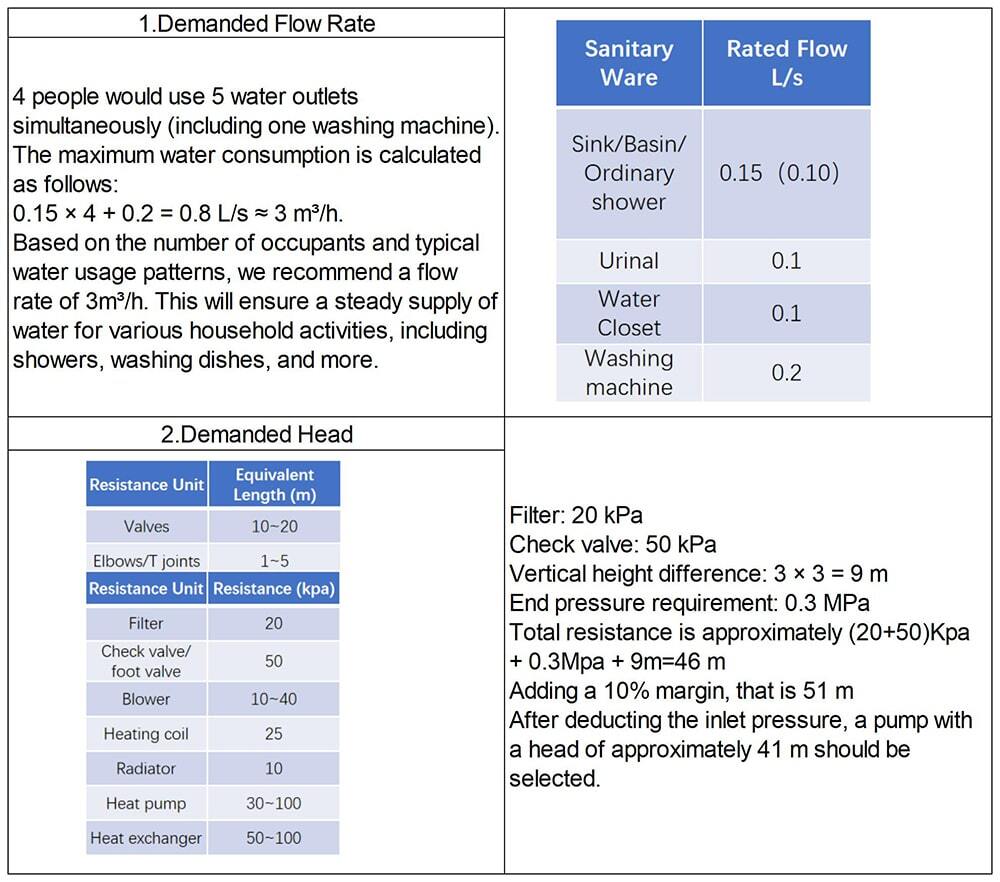
Fig 5. Guideline for choosing the proper booster pump
8. Types of Booster Pumps
Understanding the different types of booster pumps is essential for selecting the right one for your needs. Each type is designed for specific applications, offering unique benefits and limitations. Here's a detailed breakdown of the most common types of booster pumps and their ideal use cases.
1. Centrifugal Booster Pumps
Centrifugal pumps are among the most widely used booster pumps due to their efficiency and versatility.
- Single-Stage Centrifugal Pumps:
- Use a single impeller to boost water pressure.
- Ideal for applications with moderate pressure needs, such as small homes or irrigation systems.
- Compact, cost-effective, and easy to maintain.
- Multi-Stage Centrifugal Pumps:
- Feature multiple impellers in series to deliver higher pressure.
- Perfect for large homes, multi-story buildings, and systems requiring high-pressure water.
- Highly efficient for long pipelines and industrial applications.
- Vertical Multi-Stage Centrifugal Pumps:
- Designed for spaces with limited horizontal room.
- Commonly used in commercial buildings and water supply systems.
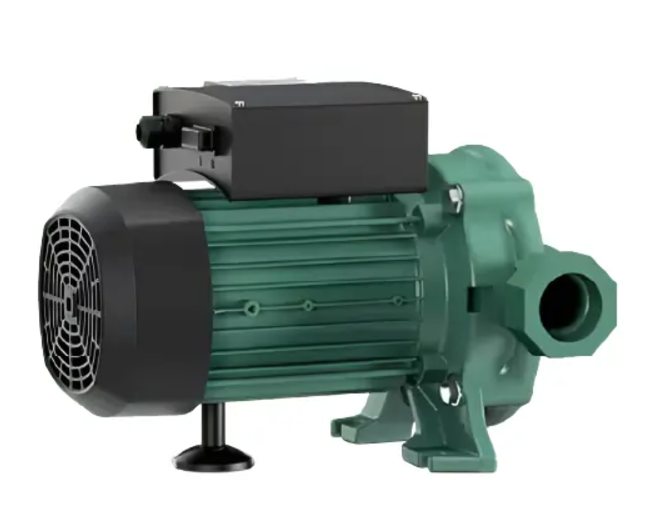
Fig 6. Non-self-priming Single-stage Centrifugal Pump
2. Jet Booster Pumps
Jet pumps are designed to lift water from wells or other below-ground sources.
- Shallow Well Jet Pumps:
- Suitable for water sources close to the surface (up to 25 feet).
- Use a single pipe for water suction and pressurization.
- Often used in small-scale residential applications.
- Deep Well Jet Pumps:
-
- Designed for water sources deeper than 25 feet.
- Use two pipes: one for suction and one for recirculation.
- Effective for deep wells and applications requiring high suction capabilities.
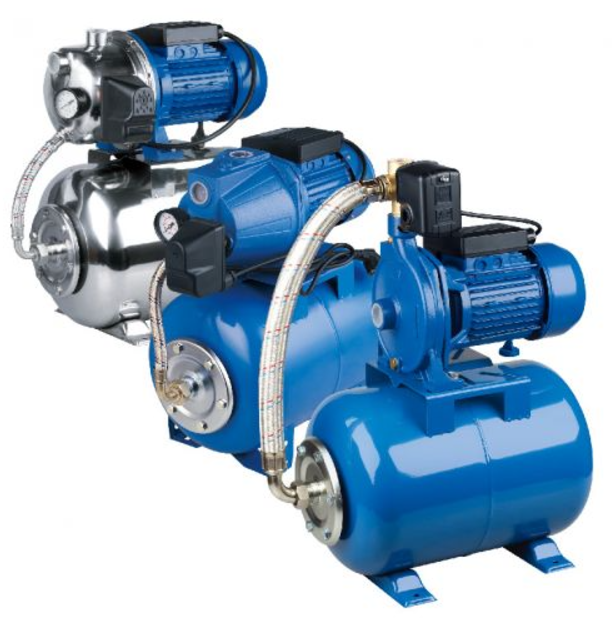
Fig 7. Jet booster pump
3. Peripheral Booster Pumps
Also known as regenerative or turbine pumps, these pumps are ideal for low-flow, high-pressure applications.
- Features:
- Use an impeller with multiple small channels to pressurize water.
- Compact and lightweight, making them easy to install and maintain.
- Applications:
- Suitable for small-scale industrial processes and systems with minimal water flow but high-pressure requirements.
4. Diaphragm Booster Pumps
Diaphragm pumps are specialized for precise and sensitive applications.
- Features:
- Use a flexible diaphragm to move water, ensuring no contamination of the fluid.
- Provide consistent and accurate flow rates.
- Applications:
- Commonly used in chemical dosing systems, medical equipment, and water purification systems.
- Ideal for handling sensitive or corrosive fluids.
5. Electromagnetic Booster Pumps
These advanced pumps use electromagnetic forces to move water and provide precise control over flow and pressure.
- Features:
- Operate without mechanical components like impellers, making them highly efficient and reliable.
- Capable of handling delicate fluids with minimal wear.
- Applications:
- Frequently used in laboratory, medical, and precision industrial settings.
Comparison of Booster Pump Types
|
Pump Type |
Pressure Capability |
Flow Rate |
Best Applications |
Advantages |
|
Centrifugal |
Low to high |
Moderate to high |
Residential, irrigation, multi-story buildings |
Energy-efficient, versatile |
|
Jet |
Low to moderate |
Low to moderate |
Shallow or deep wells, underground water sources |
Handles air well, good suction ability |
|
Peripheral |
High |
Low |
Small-scale industrial systems |
Compact, low-maintenance |
|
Diaphragm |
Moderate |
Low |
Chemical dosing, water purification, sensitive fluids |
Accurate, contamination-free operation |
|
Electromagnetic |
Low to moderate |
Low |
Laboratory, medical, and precision industrial applications |
High precision, minimal mechanical wear |
9. Benefits of Installing the Right Booster Pump
Choosing the right booster pump for your home or system is not just about solving low water pressure issues; it’s about improving your overall water usage experience, enhancing efficiency, and optimizing resource management. Here are the key benefits of selecting and installing the right booster pump:
1. Improved Water Flow and Pressure
- A booster pump ensures consistent water pressure throughout your home or system, eliminating weak showers, trickling faucets, and slow-filling appliances.
- Multi-story buildings and high-demand systems benefit from reliable water delivery, even during peak usage times.
2. Enhanced Appliance Performance
- Modern appliances like washing machines, dishwashers, and water purifiers operate more efficiently with adequate water pressure.
- High-pressure systems extend the lifespan of these appliances by reducing strain caused by inconsistent flow rates.
3. Comfort and Convenience
- Enjoy the luxury of steady water pressure for invigorating showers, efficient irrigation, and hassle-free household chores.
- Eliminate the frustration of fluctuating water pressure, especially during peak hours when multiple fixtures are in use.
4. Energy and Cost Efficiency
- Variable-Speed Pumps: Save energy by adjusting motor speed to match demand, reducing electricity consumption and lowering utility bills.
- Multi-Stage Pumps: Deliver high-pressure performance while maintaining energy efficiency for large systems.
- Fixed-Frequency Pumps: Provide a cost-effective solution for systems with consistent water pressure needs.
5. Noise Reduction
- Modern booster pumps, especially variable-speed models, operate at lower noise levels, ensuring a quieter and more comfortable environment.
- Inline and centrifugal pumps are designed to minimize operational noise, making them suitable for installations near living spaces.
6. Water Conservation
- By providing adequate pressure, a booster pump reduces the need to leave taps open longer to compensate for low flow.
- Systems with advanced controls optimize water usage, preventing wastage while maintaining desired performance levels.
7. Increased Property Value
- A reliable and efficient water pressure system is a valuable asset for any home or commercial property, enhancing its appeal and functionality.
- Potential buyers view consistent water pressure as a key feature, especially in multi-story homes or high-demand systems.
8. Extended System Lifespan
- Proper pressure management reduces strain on pipes, fixtures, and appliances, minimizing the risk of leaks, bursts, or wear and tear.
- Advanced features like soft start in variable-speed pumps protect the system from pressure surges, ensuring durability.
9. Customization and Adaptability
- Booster pumps come in various types and sizes to meet the unique demands of your water system.
- Variable-speed models adapt to changing needs, making them ideal for households with fluctuating water usage patterns.
10. Environmental Sustainability
- Energy-efficient booster pumps contribute to reduced carbon footprints by consuming less power.
- Advanced technologies, like variable frequency drives, align with sustainable water management practices by optimizing resource usage.
Investing in the right booster pump offers more than just functional benefits—it enhances your daily life, improves your water system’s performance, and contributes to long-term savings. Whether it’s a single-stage pump for a small home, a multi-stage pump for high-pressure needs, or a variable-speed pump for energy efficiency, choosing the right solution ensures a seamless and satisfying water supply experience.
In the next section, we’ll explore the future of booster pump technology and how innovations are shaping the industry to offer even greater performance and sustainability.
10. Future Trends in Booster Pump Technology
The world of booster pumps is evolving with technological advancements that are shaping the future of water pressure management. From smart integrations to energy-efficient designs, innovations in pump technology are revolutionizing how water systems operate. Here’s a look at some of the key trends that are driving the future of booster pump technology.
1. Smart and IoT-Enabled Booster Pumps
As smart home technology continues to grow, booster pumps are becoming more connected and integrated into home automation systems.
- Remote Monitoring and Control: Pumps are now equipped with sensors and IoT connectivity that allow homeowners to monitor performance and adjust settings from their smartphones or computers.
- Predictive Maintenance: Advanced sensors can detect potential issues before they become major problems, sending alerts for maintenance or repairs. This helps avoid costly downtime and extends the life of the pump.
- Energy Management: Smart pumps can optimize energy consumption by adjusting their operation based on real-time data, improving energy efficiency and reducing utility costs.
2. Increased Energy Efficiency
Energy efficiency will continue to be a driving factor in the development of booster pumps.
- Variable-Speed Technology: The adoption of variable-frequency drives (VFDs) is expected to grow, allowing pumps to adjust their speed based on demand. This not only maintains consistent water pressure but also reduces energy usage by operating the pump at only the required speed.
- Low-Energy Designs: Manufacturers are focusing on reducing power consumption by designing pumps with better motors, optimized impellers, and more efficient components. These pumps use less electricity to deliver the same performance, lowering operational costs.
- Energy Recovery Systems: In more complex systems, energy recovery devices are being integrated into booster pumps to capture excess energy and use it to power other parts of the system or to reduce energy waste.
3. Sustainable Materials and Eco-Friendly Designs
With a growing emphasis on sustainability, booster pumps are being built with eco-friendly materials and designs that minimize environmental impact.
- Recyclable Materials: Manufacturers are using recyclable and durable materials in pump construction to reduce waste and promote sustainability.
- Low-Emission Designs: Energy-efficient pumps and systems are contributing to lower carbon footprints, helping households and industries meet their sustainability goals.
- Water Conservation Features: Some pumps are equipped with advanced controls that regulate water usage, preventing wastage while maintaining optimal performance.
4. Integration with Renewable Energy Sources
As renewable energy sources become more accessible, booster pumps are being designed to integrate seamlessly with solar, wind, and other green energy systems.
- Solar-Powered Booster Pumps: These pumps are ideal for off-grid systems or areas with unreliable power sources. Solar-powered pumps provide a sustainable solution for water pressure management, especially in remote areas.
- Hybrid Systems: In areas with fluctuating energy availability, hybrid systems that combine conventional power with solar or wind energy are becoming more common. These systems ensure consistent performance even in areas where power supply is inconsistent.
5. Compact and Quiet Designs
As residential and commercial spaces become more compact, the demand for smaller, quieter pumps is on the rise.
- Space-Saving Models: New pump designs are focused on compactness, making it easier to install in tight spaces without sacrificing performance. These pumps are ideal for urban homes, apartments, and buildings with limited installation areas.
- Noise Reduction Technology: Modern pumps are designed to operate more quietly, incorporating sound-dampening materials and noise-reducing components. This makes them ideal for installations in noise-sensitive environments like homes, offices, or hospitals.
6. Enhanced Durability and Longer Lifespan
The durability and lifespan of booster pumps are improving as manufacturers invest in advanced materials and engineering.
- Corrosion-Resistant Materials: With more pumps being used in harsh or wet environments, manufacturers are using corrosion-resistant materials like stainless steel and durable coatings to ensure long-term reliability.
- Robust Design: Pumps are becoming more rugged, able to withstand high-pressure situations, extreme temperatures, and other challenging conditions, making them suitable for a wider range of applications.
7. Customizable Solutions
The trend toward customizable water pressure systems is increasing. Tailored solutions for specific applications allow homeowners and businesses to choose pumps with features that best fit their needs.
- Modular Systems: Booster pumps are becoming more modular, with customizable components such as controllers, sensors, and accessories that allow users to design systems based on specific requirements.
- Adaptable Performance: Many new pumps offer adjustable settings, such as variable flow rates and pressure thresholds, which can be easily customized to match changing water demands.
The future of booster pump technology is exciting, with continuous innovations aimed at improving efficiency, sustainability, and user experience. From smart, IoT-connected systems to eco-friendly designs and integration with renewable energy, the next generation of booster pumps will offer even more advanced, cost-effective, and sustainable solutions for managing water pressure.
As technology evolves, so do the options available to homeowners, businesses, and industries. Whether you’re looking for energy-efficient designs, quiet operation, or the ability to integrate with your smart home system, the future of booster pumps holds the promise of smarter, more reliable, and more sustainable water management solutions.
11. Conclusion
Choosing the right booster pump is a vital step in addressing low water pressure and optimizing your water system’s performance. Whether you’re dealing with fluctuating water demand, multi-story home challenges, or the need for energy-efficient solutions, understanding the unique features and benefits of single-stage, multi-stage, and variable-speed booster pumps is key to making an informed decision.
Recap of Key Points:
- Single-Stage Booster Pumps are cost-effective and ideal for low-demand systems, providing moderate pressure for simple applications like single-story homes or small irrigation setups.
- Multi-Stage Booster Pumps deliver high pressure and are perfect for large homes, multi-story buildings, and systems with long pipelines or high-demand irrigation.
- Variable-Speed Booster Pumps offer advanced technology, maintaining constant pressure, reducing energy consumption, and ensuring quiet operation. They are the best choice for fluctuating water demand and modern, energy-conscious households.
Why Choosing the Right Pump Matters:
- Improved Daily Comfort: A properly selected booster pump ensures a consistent water supply, making daily tasks like showering, washing, and watering hassle-free.
- Enhanced Efficiency: The right pump reduces energy waste, cuts operational costs, and prolongs the life of your appliances and water system.
- Long-Term Reliability: Investing in the right pump minimizes maintenance issues and prevents system failures caused by pressure imbalances or overuse.
Next Steps for Your Water Pressure Solution:
- Assess Your Needs: Evaluate your home or system’s specific requirements, such as water source, flow rate, and pressure demands.
- Choose the Right Type: Match the pump type—single-stage, multi-stage, or variable-speed—to your needs for the best results.
- Consult a Professional: For precise calculations and installation guidance, consult an expert to ensure you get the right pump for your system.
- Invest in Quality: Opt for trusted brands and models to ensure reliability, durability, and long-term satisfaction.
Your Reliable Water Pressure Partner
A booster pump is more than just a solution to low water pressure—it’s an investment in your comfort, efficiency, and peace of mind. By selecting the right pump, you’re not only solving immediate challenges but also ensuring your water system operates seamlessly for years to come.
If you’re ready to master the flow and transform your water pressure experience, reach out to us today. Our team of experts is here to guide you in selecting the perfect booster pump for your needs. Explore our range of high-quality pumps or get in touch for personalized recommendations. Don’t let low water pressure hold you back—elevate your system and enjoy the benefits of a perfectly optimized water supply!
FAQs
- What is the purpose of a booster pump?
A booster pump is designed to increase water pressure and flow in plumbing or water supply systems. It’s used in situations where existing water pressure is insufficient, such as in multi-story homes, irrigation systems, or during peak water usage times.
- How do I know if I need a booster pump?
You may need a booster pump if:
- Your shower pressure is weak, or faucets flow inconsistently.
- Appliances like washing machines or dishwashers don’t perform efficiently due to low water pressure.
- Water pressure drops significantly during peak usage times.
- You live in a multi-story home or a property at a higher elevation where gravity reduces water pressure.
- What’s the difference between single-stage, multi-stage, and variable-speed booster pumps?
- Single-Stage Pumps: Best for low-demand applications, providing moderate pressure.
- Multi-Stage Pumps: Designed for high-pressure needs, ideal for multi-story homes and large systems.
- Variable-Speed Pumps: Adapt to fluctuating demand, maintaining constant pressure and maximizing energy efficiency.
- How do I calculate the right booster pump size for my home?
To size a booster pump:
- Calculate your household’s peak water flow demand (e.g., in liters per minute or gallons per minute).
- Determine the required pressure (e.g., for upper floors or high-pressure fixtures).
- Consider your water source’s characteristics (e.g., municipal supply, well, or storage tank). Consult a professional for precise calculations based on these factors.
- Are booster pumps energy-efficient?
Yes, especially variable-speed booster pumps. They adjust motor speed to match water demand, reducing energy consumption compared to fixed-speed pumps that operate continuously at full capacity.
- Can booster pumps be noisy?
Some booster pumps, like jet or single-stage pumps, may produce moderate noise, especially if installed near living spaces. However, modern designs, such as variable-speed or inline pumps, incorporate noise-reduction features for quieter operation.
- How often do booster pumps require maintenance?
The frequency of maintenance depends on the type of pump and usage. Regular tasks include:
- Checking and replacing filters.
- Inspecting impellers and seals for wear.
- Cleaning components to prevent debris buildup. Most modern pumps are designed for low maintenance, and periodic servicing can prolong their lifespan.
- Can I install a booster pump myself?
While some booster pumps come with straightforward installation instructions, it’s recommended to hire a professional plumber to ensure proper setup. Professional installation minimizes the risk of leaks, improper operation, and damage to your plumbing system.
- Do booster pumps work with all water sources?
Yes, but the type of booster pump needed depends on the water source:
- Municipal Water: Most booster pumps are compatible.
- Wells: Jet or self-priming pumps are ideal.
- Storage Tanks: Ensure compatibility with fluctuating water levels and consider installing a pre-filter.
- What is the lifespan of a booster pump?
A well-maintained booster pump can last 7–15 years, depending on the model, usage, and maintenance. High-quality pumps from trusted manufacturers typically offer longer lifespans and better reliability.
References
https://famcocorp.ae/blog/pumps-articles/what-are-the-types-of-booster-pumps/
https://www.streampumps.com/pump-introductions/4-tips-to-choose-a-booster-pump-for-your-home.html
https://www.streampumps.com/pump-knowledge/20231103.html
https://www.streampumps.com/pump-solutions/home-booster-pump-choose-guide.html
https://s.alicdn.com/@sc04/kf/H0f9dbd3675df4a9a86432ed12ee53113g.jpg_720x720q50.jpg
Recent Posts
-
Single-Stage, Multi-Stage, and Variable Speed Booster Pumps: Which One is Right for You?
1. Introduction Is your shower lacking the invigorating pressure you crave? Do your faucets tri …13th Apr 2025 -
Process Connection Unveiled: Decoding the Art of Pressure Sensor Fittings
Process Connection or Fitting of a Pressure Transmitter The process connection or fitting of a …5th Apr 2025 -
Troubleshooting Common Water Pump Problems: A Step-by-Step Guide
Introduction Water pumps are essential components in a wide range of settings, from homes and f …1st Apr 2025

